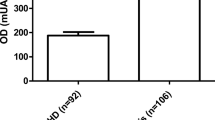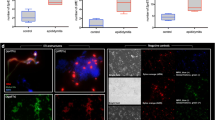Abstract
Increased numbers of eosinophilic granulocytes and eosinophil degranulation have been observed in various inflammatory conditions. Biopsies from the fallopian tubes of 28 patients were examined for the content of eosinophilic granulocytes. Peritoneal fluids (PF) from 89 patients were analyzed for the concentrations of eosinophilic granulocytes and the granule protein eosinophil cationic protein (ECP). The ECP levels in the PF were substantially elevated during genital inflammation (P < 0.001). Furthermore, one week after laparotomy for adhesiolysis there were both increased PF-ECP levels (P < 0.01) and raised concentrations of eosinophilic granulocytes (P < 0.001) when compared to the reference group. Staining of the biopsies with monoclonal antibodies revealed an increased total number as well as a number of activated eosinophilic granulocytes in specimens from adhesions and sactosalpinx compared to specimens from normal fimbriae. The findings indicate that eosinophilic granulocytes may have a possible role in the fibrotic process of pelvic adhesion disease.
Similar content being viewed by others
References
Roitt, I. M., J. Brostoff, andD. K. Male. 1987. Cells involved in the immune response.In Immunology, Vol. 2. I. Roitt, J. Brostoff and D. Male, editors. Gower Medical Publishing, London, 2:1–16.
Spry, C. J. F. 1988. Cardiovascular diseases.In Eosinophils, Vol. 21. C. J. F. Spry, editor. Oxford University Press, Oxford, U.K. 228–238.
Spry, C. J. F. 1988. Lung diseases.In Eosinophils, Vol. 15. C. J. F. Spry, editor. Oxford University Press, Oxford, U.K. 205–212.
Beeson, P. B. 1980. The clinical significance of eosinophilia.In The Eosinophil in Health and Disease. A. A. F. Mahmoud, K. F. Austen and A. S. Simon, editors. Grune & Stratton, New York, 313–321.
Venge, P., R. Dahl, R, Hällgren, andI. Olsson. 1980. Cationic proteins of human eosinophils and their role in the inflammatory reaction.In The Eosinophil in Health and Disease. A. A. F. Mahmoud, K. F. Austen and A. S. Simon, editors. Grune & Stratton, New York, 131–144.
Thompson, W. D., R. Campbell, andT. Evans. 1985. Fibrin degradation and angiogenesis.J. Pathol. 145:27–37.
Nolph, D. K., M. J. Sorkin, B. F. Prowant, J. M. Kennedy, andE. D. Everatt. 1982. Asymptomatic eosinophilic peritonitis in continuous ambulatory peritoneal dialysis (CAPD).Dial. Transplant 11:309–313.
Rowland, M., R. B. Brown, andM. Goldman. 1985. Eosinophilic peritonitis: An unusual manifestation of spontaneous bacterial peritonitis.J. Clin. Gastroenterol 7(4):369–371.
Nässberger, L., andA. Arbin. 1987. Eosinophilic peritonitis-hypothesis.Nephron 46:103–104.
Soto, J., A. N. Tchernichin, P., Poloni, G. Voigt, B. Caro, andM. Agurto. 1989. Effect of ketotifen on the distribution and degranulation of uterine eosinophils in estrogen-treated rats.Agents Actions 28(3–4):198–203.
Lugue, E. H., andG. S. Montes. 1989. Progesteron promotes a massive infiltration of the rat uterine cervix by the eosinophilic polymorphonuclear leukocytes.Anat. Rec. 223(3):257–265.
The American Fertility Society. 1985. Revised American Fertility Classification of endometriosis.Fertil. Steril. 43:351–352.
Coulam, C. B., S. B. Moore, andW. O'Fallon. 1988. Investigating unexplained infertility.Am. J. Obstet. Gynecol. 158:1374–1381.
Edelstam, G. A. B., E. Ö. Lundkvist, P. Venge, andT. C. Laurent. 1994. Hyaluronan and myeloperoxidase in human peritoneal fluid during genital inflammation.Inflammation 18(1):13–21.
Grinnell, F., M. Milam, andP. A. Srere. 1972. Studies on cell adhesion.Arch. Biochem. Biophys. 153:193–198.
Mason, T. E., R. Phifer, S. S. Spicer, R. A. Swallow, andR. B. Dreskin. 1969. An immunoglobulin-enzyme bridge method for localising tissue antigens.J. Histochem. Cytochem. 17:557–560.
Naish, S. J., editor. 1989. Immunohistochemical Staining Methods. Handbook. DAKO Corporation.
Olsson, I., P. Venge, J. K. Spitznagel, andR. Lehrer. 1977. Arginine-rich cationic proteins of human eosinophil granules.Lab. Invest. 36:493–500.
Venge, P., L. E., Roxin, andI. Olsson. 1977. Radioimmunoassay of human eosinophil cationic protein.Br. J. Haematol. 37:331–335.
Tai, P.-C., C. J. Spry, C. Peterson, P. Venge, andI. Olsson. 1984. Monoclonal antibody distinguish between storage and secreted forms of eosinophil cationic protein.Nature 309:182–184.
Colton, T. 1974. Nonparametric methods.InStatistics in medicine. T. Colton, editor. Little, Brown and Company, Boston, Massachusetts. 219–227.
Cook, R. M., N. R. J. Musgrove, andR. F. Ashworth. 1987. Activity of rat peritoneal eosinophils following induction by different methods.Int. Arch. Allergy Appl. Immunol. 83:423–427.
Daugirdas, J. T., D. J. Leehey, S. Popli, W. Hoffman, I. Zayas, andV. C. Gandhi. 1987. Induction of peritoneal fluid eosinophilia and/or monocytosis by intraperitoneal air injection.Am. J. Nephrol. 7:116–120.
Noguchi, H., G. M. Kephart, T. V. Colby, andG. J. Gleich. 1992. Tissue eosinophilia and eosinophil degranulation in syndromes associated with fibrosis.Am. J. Pathol. 140(2):521–528.
Edelstam, G. A. B., E. Ö. Lundkvist, A. F. Wells, andT. C. Laurent. 1991. The localization of hyaluronan in the regions of the female reproductive tract.J. Histochem. Cytochem.39(8):1131–1135.
Laatikainen, T. J., A. K. Tenhunen, P. K. Venesmaa, andD. L. Apter. 1988. Factors influencing the success of microsurgery for distal tubal occlusion.Arch. Gynecol. Obstet. 243:101–106.
Boer-Meisel, M. E., E. R. TeVelde, J. D. F. Habbema, andJ. W. P. F. Kardaun. 1986. Predicting the pregnancy outcome in patients treated for hydrosalpinx: A prospective study.Fertil. Steril. 45:23–29.
Author information
Authors and Affiliations
Rights and permissions
About this article
Cite this article
Edelstam, G., Fredens, K. & Venge, P. Role of eosinophilic granulocytes in women with infertility and pelvic adhesions. Inflammation 18, 361–371 (1994). https://doi.org/10.1007/BF01534434
Issue Date:
DOI: https://doi.org/10.1007/BF01534434




